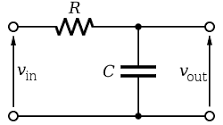Bad cables can have a tremendous impact on signal transmission and the resulting sound quality.
Bad cables can ruin a signal by 60..70% - compared to high-quality cables with high-grade connectors.
Chiefly two factors are coming into view when focussing on just the cable material:
- Resistance (R)
- Capacity (C)
These are not electronic components but 'material constants' implied
by any piece of wire shown here as a so-called 'equivalent circuit'.
So depending on the cable length resistance and capacity grow with
cable length.

Spoken in terms of electronics ...
Every cable constitutes a 'low-pass' (or 'high-cut') filter
I.e. any cable cuts-off higher frequencies at a specific 'cut-off frequency' (fc) that
can be calculated from the real values of R and C.
Resistance (R) and capacity (C) are below the line in the formula, which means:
The higher R and/or C the lower the cut-off frequency ...
... i.e. overtones are cut-off earlier
So what is so detrimental with cables that have higher resistance and/or
capacity due to its lower quality?
Well - bad cables will cut-off the overtones which are the foundation of a
good and natural tone from your instrument. If you experience a flaw and
dull tone coming from speakers don't change your equipment.
Change your type of pickup system and the cables that connect on 'the first mile'
with your pre-amp input.

Looking closer onto a cable such a cable constitutes of:
- the cable material
- the connectors - one on each end, which doubles the so-called 'transition resistance'.
The cable material itself often isn't the culprit for a dump and dull sound.
The much bigger impact comes from bad connectors as is explained in another article about connector materials their 'plating' and the technology they use.

